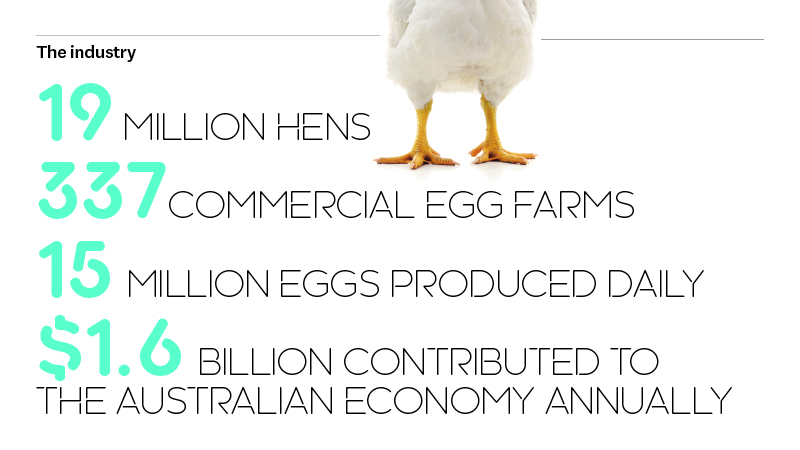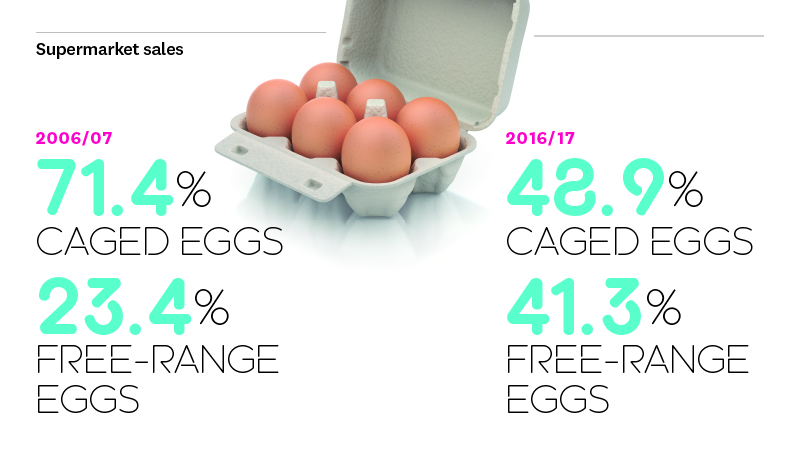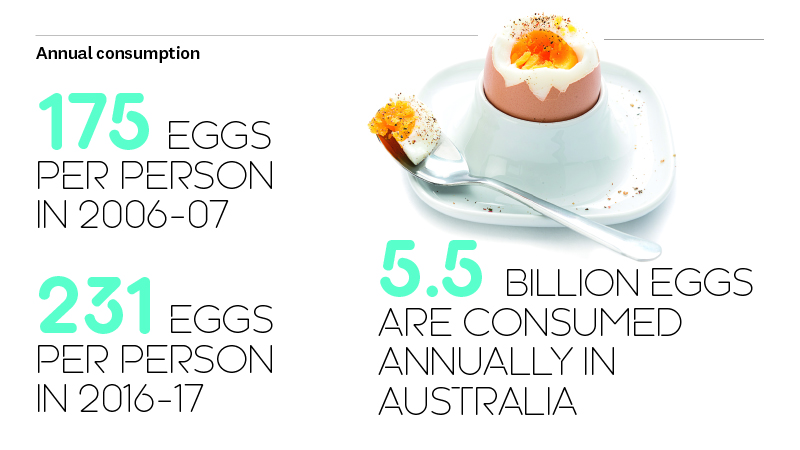for poultry farming, covering everything from pheasants to ostriches, was brought into effect. Since then, the free-range versus caged chicken egg debate has gained serious momentum and considerable press.
and Guidelines for Poultry, released for comment in November 2017, has been more hard-fought than for any other livestock sector, with allegations of government corruption and public bullying of caged-egg producers.
According to national peak body
Egg Farmers of Australia, the sector contributes about $1.6 billion to the economy annually and produces about 15 million eggs a day for the domestic market, with about half going to supermarkets and the rest to food manufacturers and restaurants. Of the 337 commercial egg farms in Australia, about 98% are family owned and operated, and any changes to model welfare codes will have a real and lasting impact on producers.

Bede Burke, chair of NSW Farmers’ Egg Committee, has farmed caged eggs for nearly four decades at his property near Tamworth in North West NSW – and has seen it before. He lived through the introduction of quotas in the 1980s and the subsequent deregulation of the industry, as well as the changes required when the last standards and guidelines were introduced in 2002.
Those changes meant his family had to put in new cage systems. “Our old assets had to be completely done away with and trashed because the old cages installed in 1984 were made illegal,” Bede says.
CAGED-EGG BANS COULD INCREASE EGG PRICES

Egg Farmers of Australia chief executive John Dunn estimates more than half a billion dollars has been spent by farmers since then to upgrade cages and conditions and says a regulated ban on caged eggs rolled out over the next decade – one of a number of options under consideration for the new guidelines – would increase the cost of eggs by 30%.
Animal rights groups regularly point to European Union legislation and Canadian laws that have banned battery-caged eggs as an example Australia should be following. However some groups, including the RSPCA, don’t make it clear the ban only extends to swapping existing cages for “furnished cages”, something under discussion as part of the new guidelines in Australia. EU regulations in place since 2012 stipulate all hens must have a minimum amount of space, with access to a nest box, a perch and litter area, designed to allow hens to engage in a larger range of normal behaviours.
Interested in attending an industry poultry meat forum? Come listen to speakers, ask questions and have your say on critical issues affecting the industry.
Register interest HERE
- Mittagong - 6 September 2019
- Beresfield - 20 September 2019
FURNISHED CAGES MAY NOT BE THE SOLUTION
Bede says the prospect of requirements for furnished cages poses a real dilemma for the Australian industry. On a practical level, because they are different sizes and shapes, they won’t fit the internal structure of many farmers’ existing sheds. He also questions the benefit of furnished cages over existing cages.
“A furnished cage sounds so lovely doesn't it, but what does it deliver? Nothing,” Bede says.
Bede explains that the furnished cages he has seen cause more production system problems and issues around hen welfare than existing systems. He says farmers exceeded the standards imposed in 2002. “We had things like manure removal systems and climate control. We weren’t asked to do that.”
*READ more about the innovation of manure removal systems in “The power of pig poo” featuring Riverina pig farmers who capture methane gas and convert into electricity.
In three months of public consultation around the draft standards and guidelines, which closed in February, 167,000 submissions were received. An independent summary of the submissions was presented to
Animal Health Australia (AHA) in June, noting the majority of submissions were pro forma responses from public campaigns with only about 200 considered substantive responses.
The summary report identified the use of cages, beak trimming, alternate-day feeding strategies, stocking density, lighting for housed poultry and humane dispatching of male layer chicks as key areas of concern.
IMPROVING ANIMAL WELFARE OUTCOMES
A 280-page regulatory impact statement (RIS) used to assess the cost-benefit impact of the proposed changes, suggests it would cost the industry nearly $710 million to implement the new national standards as drafted. These proposed standards include suggestions to improve animal welfare outcomes, but do not ban cages outright. This is compared with $1.5 billion for another option, where cages would be phased out over the next decade.
Egg Farmers of Australia estimates about one in four people still buy caged eggs.
70% of those buyers earn less than the average wage. John Dunn says a price increase forced by regulation changes would impact access to what has traditionally been the cheapest source of animal protein.

In a submission to AHA, NSW Farmers says it “strongly prefers” implementing the new draft national standards, stating: “This will deliver clear improvements to animal welfare, meets community expectations, and addresses the current regulatory failures.”
The option to phase out cages is not tenable as it “will not improve animal welfare outcomes, does not align with the community’s expectations and will impose unacceptable costs on the industry”, the submission reads.
*READ more information from the NSW Farmers’ Egg Committee regarding priority areas, policy and briefing notes about egg production.
CAGED EGGS VS FREE-RANGE: DO CONSUMERS KNOW THE DIFFERENCE?